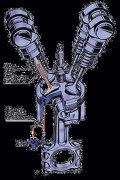The Mazda 323 4WD GT-R is powered by an evolution version of the turbocharged and intercooled, type BPD, twin-overhead-camshaft, 16-valve, 1.839 cc, inline 4-cylinder engine. This power plant has been specifically developed for the GT-R by Mazda's Motor Sports Engineering Group. The type BPD "Big Turbo" produces 136 kW EEC (139 kW DIN) at 5,000 rpm and a maximum torque of 235 Nm EEC (240 Nm DIN) at 4,500 rpm, figures which are 13 and 8 % higher, respectively, than the output of the type BPD Turbo that powers the 323 4WD GTX. The engine's strengths, both power output and torque characteristics, are in the mid-through-high-rpm zone, above 3,000 rpm up to its maximum allowable 7,000revs. Numerous improvements have been carried out in the engine's internals, and the new "Big Turbo" and larger and more direct intercooler system is adopted in the GT-R unit.
The evolution version of the Type BPD, DOHC, 16-valve, EGI/Turbocharged Engine.
The type BPD DOHC engine has an 83.0 mm bore and an 85.0 mm stroke for a total capacity of 1,839 cc. The compression is 8.2:1 and the engine requires premium unleaded fuel (minimum RON 95). The cylinder head is precision diecast aluminum, carrying twin overhead camshafts. The single-stage, cogged-belt-driven camshafts operate 4 valves per cylinder via inverted bucket tappets that incorporate hydraulic lash adjusters, which maintain precise clearance without periodic adjustment. The camshafts are hollow-cast to reduce weight, each camshaft being 500 grams lighter than a comparable solid camshaft. The valves are Vee-inclined at an included single of 50 degrees in a compact pentroof combustion chamber with squish area. The spark plug is centrally located in the combustion chamber. Valve diameters are 33 mm (intake) and 28 mm (exhaust) having 8.0 mm and 8.5 mm lifts, respectively. The exhaust valves are sodium cooled. Encased within each thin, hollow, 6 mm valve stem is metallic sodium, which, when exposed to heat, liquefies and helps dissipate heat from the head of the valve.
Further, the piston's top ring groove area is reinforced with integrally cast nickel-based "metal foam". the nickel foam is produced by electroplating urethane foam, which is then melted away, leaving porous metal "foam". The foam ring is integrally cast in the piston by the squeeze-casting method. The metal reinforced, squeeze-cast piston with cooling channel was first adopted in Mazda's direct-injection diesel engine, whose piston are subjected to extremely high thermal load during the combustion process. The metal reinforced piston is about 10 % lighter as compared with an aluminum piston with Niresist top ring groove, and according to Mazda's testing has an extended piston life by threefold. The piston's skirt is also zinc-plated for improved wear resistance, and its inside is cooled by an oil jet. The forged steel connecting rods have a larger section for added strength. The connecting rod's big-end bearing is now of a racing-type kelment metal. The cast iron cylinder block's lower opening is reinforced by a Main Bearing Support Plate (MBSP), an intercately shaped steel plate which has dual functions: stiffening the block and effectively reducing vibrations, and securely supporting the lower cranshaft bearing caps. The oil sump is made of rigid, sound-damping diecast aluminum. Its front end is bolted onto the transaxle casting, contributing to overall power unit rigidity.
Fuel injection is by the latest digital-electronically managed, L-jetronic, multi-port injection system, with a flap-type airflow metering device. Fuel is injected to two cylinders simultaneously (cylinder 1 and 3 in one group and 2 and 4 in the other), in sequence. The lubrication system employs a high-pressure pump, and a water-cooled oil-cooler is integral with the filter. Ignition is electronically controlled with the engine control unit (ECU) determining option ignition timing by signals collected from the distributor, throttle sensor, airflow meter, coolant temperature sensor and knock sensor.


|